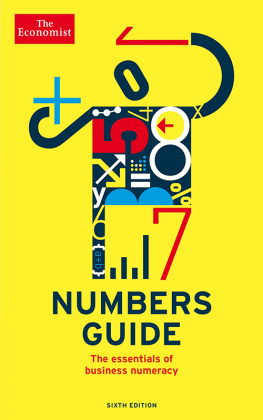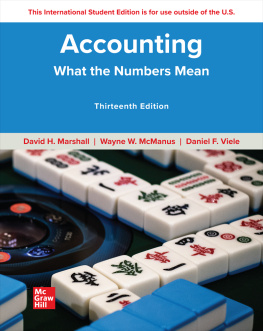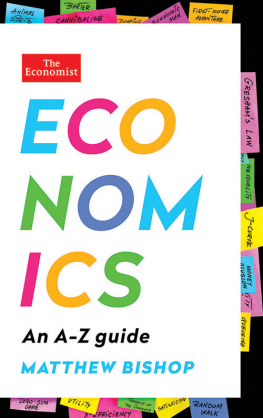
NUMBERS GUIDE
OTHER ECONOMIST BOOKS
Guide to Analysing Companies
Guide to Business Modelling
Guide to Business Planning
Guide to Cash Management
Guide to Commodities
Guide to Decision Making
Guide to Economic Indicators
Guide to Emerging Markets
Guide to the European Union
Guide to Financial Management
Guide to Financial Markets
Guide to Hedge Funds
Guide to Investment Strategy
Guide to Management Ideas and Gurus
Guide to Managing Growth
Guide to Organisation Design
Guide to Project Management
Guide to Supply Chain Management
Style Guide
Book of Business Quotations
Book of Isms
Book of Obituaries
Brands and Branding
Business Consulting
Business Strategy
Buying Professional Services
Doing Business in China
Economics
Managing Talent
Managing Uncertainty
Marketing
Marketing for Growth
Megachange the world in 2050
Modern Warfare, Intelligence and Deterrence
Organisation Culture
Successful Strategy Execution
The World of Business
Directors: an AZ Guide
Economics: an AZ Guide
Investment: an AZ Guide
Negotiation: an AZ Guide
Pocket World in Figures

NUMBERS GUIDE
The Essentials of Business Numeracy
Sixth edition
THE ECONOMIST IN ASSOCIATION WITH
PROFILE BOOKS LTD
Published by Profile Books Ltd
3A Exmouth House, Pine Street, London EC1R 0JH
www.profilebooks.com
First published by The Economist Books Ltd 1991
Copyright The Economist Newspaper Ltd, 1991, 1993, 1997, 2001, 2003, 2014
Text copyright Richard Stutely, 1991, 1993, 1997, 2001, 2003, 2014
Diagrams copyright The Economist Newspaper Ltd, 1991, 1993, 1997, 2001, 2003, 2014
All rights reserved. Without limiting the rights under copyright reserved above, no part of this publication may be reproduced, stored in or introduced into a retrieval system, or transmitted, in any form or by any means (electronic, mechanical, photocopying, recording or otherwise), without the prior written permission of both the copyright owner and the publisher of this book.
The greatest care has been taken in compiling this book.
However, no responsibility can be accepted by the publishers or compilers for the accuracy of the information presented.
Where opinion is expressed it is that of the author and does not necessarily coincide with the editorial views of The Economist Newspaper.
A CIP catalogue record for this book is available from the British Library
E-book 978 1 84765 934 7
List of tables
List of figures
Introduction
Statistical thinking will one day be as necessary a qualification for efficient citizenship as the ability to read and write.
H.G. Wells
T HIS BOOK is about solving problems and making decisions using numerical methods. Everyone people in business, social administrators, bankers can do their jobs better if equipped with such tools. No special skills or prior knowledge are required. Numerical methods amount to little more than applied logic: they all reduce to step-by-step instructions and can be processed by simple computing devices. Yet numerical methods are exciting and powerful. They work magic, which is perhaps why they are shrouded in mystery. This book strips away that mystery and provides a guided tour through the statistical workshop. There are no secrets, no barriers to entry. Anyone can use these tools. Everyone should.
What are numerical methods?
Numerical methods range from the simple (how to calculate percentages and interest) to the relatively complex (how to evaluate competing investment opportunities); from the concrete (how to find the shortest route for deliveries) to the vague (how to deal with possible levels of sales or market share). The link is quantitative analysis, a scientific approach.
This does not mean that qualitative factors (intangibles such as personal opinion, hunch, technological change and environmental awareness) should be ignored. On the contrary, they must be brought into the decision process, but in a clear, unemotional way. Thus, a major part of this book is devoted to dealing with risk. After all, this forms a major part of the business environment. Quantifying risk and incorporating it into the decision-making process is essential for successful business.
In bringing together quantitative techniques, the book borrows heavily from mathematics and statistics and also from other fields, such as accounting and economics.
A brief summary
We all perform better when we understand why we are doing something. For this reason, this book always attempts to explain why as well as how methods work. Proofs are not given in the rigorous mathematical sense, but the techniques are explained in such a way that the reader should be able to gain at least an intuitive understanding of why they work. This should also aid students who use this book as an introduction to heavier statistical or mathematical works.
The techniques are illustrated with business examples where possible but sometimes abstract illustrations are preferred. This is particularly true of probability, which is useful for assessing business risk but easier to understand through gamblers playing cards and coins.
Examples use many different currencies and both metric and imperial measurements. The SI standards for measurement (see SI units in the AZ) are excellent, but they are generally ignored here in favour of notation and units which may be more familiar to a wider audience.
This book works from the general to the particular.
lays the groundwork by running over some key concepts. Items of particular interest include proportions and percentages (which appear in many problems) and probability (which forms a basis for assessing risk).
examines ways of dealing with problems and decisions involving money, as many or most do. Interest, inflation and exchange rates are all covered. Note that the proportions met in the previous chapter are used as a basis for calculating interest and evaluating investment projects.
looks at summary measures (such as averages) which are important tools for interpretation and analysis. In particular, they unlock what is called the normal distribution, which is invaluable for modelling risk.
reviews the way data are ordered and interpreted using charts and tables. A series of illustrations draws attention to the benefits and shortfalls of various types of presentation.
examines the vast topic of forecasting. Few jobs can be done successfully without peering into the future. The objective is to pull together a view of the future in order to enhance the inputs to decision-making.
the chapter then goes on to look at ways of reaching the best decision from sample data. The techniques are important for better decision-making in general.
expands on the decision theme. It combines judgment with the rigour of numerical methods for better decisions in those cases which involve uncertainty and risk.
looks at some rather exciting applications of techniques already discussed. It covers:
- game strategy (for decision-making in competitive situations);
- queueing (for dealing with a wide range of business problems, only one of which involves customers waiting in line);
- stock control (critical for minimising costs);
Next page







